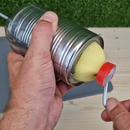Introduction: Wireless AC Current Detector
While making my previous Instructable (easy infrared proximity sensor) I figured out a few things about using 2 transistors in a row to amplify a very weak signal. In this Instructable I will elaborate on this principle which is also called the "Darlington principle".
In this circuit, an antenna (spring) is connected to the base of first transistor. When we place this antenna near an object that is AC energized, a small current gets induced into the antenna due to electromagnetic induction. This current triggers the first transistor. Output of the first transistor triggers the second. The second transistor switches on the LED indicating that AC voltage is present.
Video tutorial
Supplies
- 2 BC547 transistors
- LED
- 220 Ohm resistor
- Spring (ballpoint spring or copper wire)
- 9V Battery
- 9V Battery clip
Step 1: Connecting the Transistors
Describing this step is very laborious. The images make it a lot clearer!
- Bend the collector of transistor 1 ninety degrees
- Bend the base of transistor 1 all the way over the transistor
- Bend the collector of transistor 2 ninety degrees
- Connect the emitter from transistor 1 to the base of transistor 2
- Connect the collector from transistor 1 to the collector of transistor 2
- Cut off the protruding ends
- Bend the protruding end where the collectors are connected 90 degrees
Step 2: Connecting the Resistance
The second transistor controls the LED. A resistor must intervene here to protect the LED. In this circuit I am using a 220 ohm resistor.
The resistor can be placed in front of or behind the LED and works the same in both directions. To keep the whole compact so that it can be placed on the battery connector later, it comes directly after the transistor.
- Solder the resistor to the emitter (output) of the second transistor.
- Bend the other pin 90 degrees and cut it shortly after the bend.
Step 3: Connecting the LED
- Bend the anode (+) of the LED 90 degrees and cut it to a few millimeters.
- Solder the anode to the resistor.
- Cut the cathode (-) to the same length as the pin protruding from the connected emitters.
The 2 protruding pins should have about the same pitch as the 2 connectors of the battery connector. This is because the whole can be mounted on the battery connector later.
Step 4: Prepare the Connector.
The whole is mounted on the connector in the next step. For this, the connector must first be adjusted a little.
- Cut the wires coming out of the connector.
- Drill 2 small holes of about 2 millimeters through the connector.
Step 5: Mount the Connector
- Slide the 2 protruding pins through the connector.
- Solder the pins to the connector.
The pin of the collectors to the + connector, the pin of the cathode of the LED comes to the - connector.
Step 6: Install the Spring
A spring is attached to the base connection of transistor 1. This will function as an antenna to receive the electromagnetic induction from the AC circuit.
- Slide the feather over the base and solder the connection.
If you don't have a feather, you can also make a spiral from, for example, a piece of copper wire.
Step 7: Ready
The Wireless AC Current Detector is ready! You only have to click it on the battery and you can use it.
Note that this is a hobby project to understand how transistors work! Always use approved tools when working on an electrical installation!
Update: User raddevus made a schematic of the circuit, it is included in the pictures of this step. Thanks raddevus!
Video tutorial:




